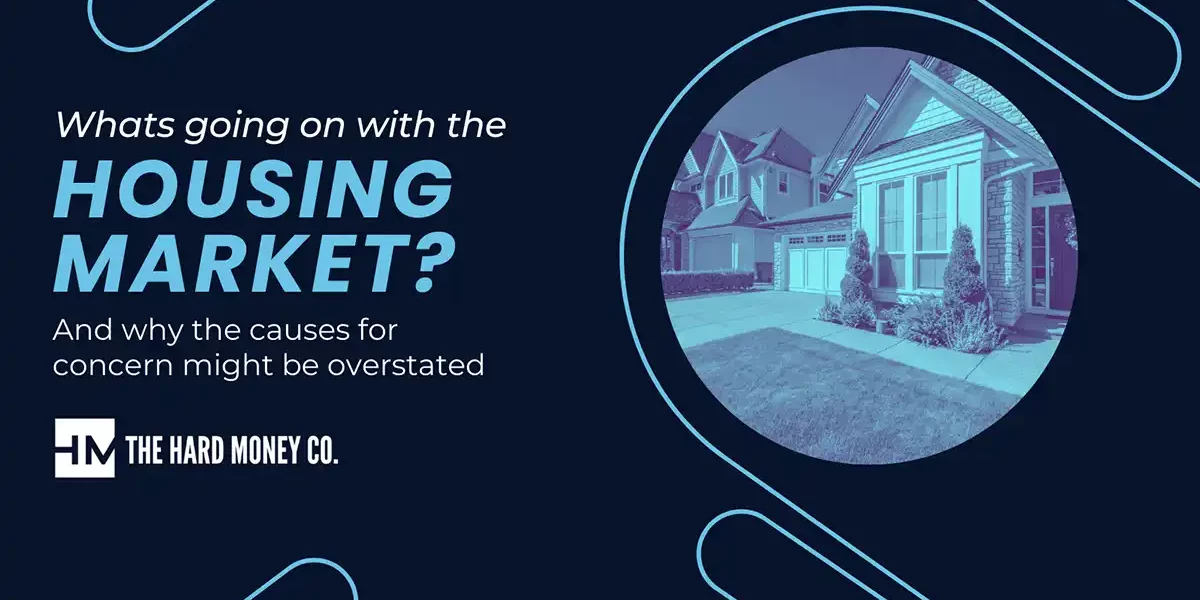If you've paid any attention in recent months, you likely have seen something regarding the tenuous status of the world economy. The stock market has been in flux, interest rates are rising, and we are still dealing with levels of inflation that we haven't experienced in a number of years. As real estate investors, you may have concerns about how this level of volatility affects your current investments and future plans. And while there are plenty of reasons for increased vigilance, the savvy investor has little reason to panic.
At The Hard Money Co., we've taken a look at the housing market as a whole and identified some key characteristics of its current state. Possessing a firm understanding of the market and where its headed will give you a strong foundation for investment moving forward, and may even expose opportunities that others have not yet identified. What follows are some clickbait headlines that you might commonly see, and some reasons why there might not be the cause for alarm that many suggest.
Mortgage Rates Are Rising!
Interest rates are rising with the prime rate hitting 4.75% this week. Depending on the specifics of your financial situation and your proposed real estate investment, this means that you're likely seeing mortgage rates as high as 6.5%. If you began your investing career in the last 10 years, these rates might seem prohibitive. High-interest rates eat into your profit potential, diminishing your cash flow and reducing your opportunities for easy financing on future transactions. But these rates are only 'expensive' in the context of the last decade. Through much of the 80s, 90s, and 2000s, rates were consistently this high with peaks up to 18% in '81!
Predicting future rates beyond the next few months is a fool's errand and waiting out the Fed for a return to 2.5% interest rates could put you on the sideline for years. As a motivated investor in it for the long run, you should accept that the market is beyond your control and pursue one of two courses of action.
The first is to embrace the current rates and adjust your strategy and projections to match. As the cost of financing rises, there will be fewer entrants to the investment marketplace and you will find opportunities on properties that may have been inaccessible before. It may make sense to step back and take a breather, but removing yourself from the field entirely is not a solution.
The second course of action is to identify new sources of capital and investment strategies that reduce your exposure to long terms of high rates. Consider what it might look like to bring in capital from friends, family, or elsewhere. Their cost of capital may not be much higher than banks, but with substantially more amenable terms. You can even bring them on as equity partners and avoid the financing costs altogether. Having multiple ways to finance a project is always beneficial, regardless of the lending climate.
Asset Appreciation is Grinding to a Halt!
As interest rates rise and there are fewer buyers on both the investment and personal residency sides of the market, home prices may not continue to grow at the rate we've recently seen. The year-over-year jumps of 20-30% were always untenable, but that doesn't mean that your investment won't continue to grow. According to the Federal Reserve Economic Data, compound annual growth for the last 50 years has averaged 5.7% with only one drawdown lasting more than 5 years.
This should give you confidence that your buy-and-hold investments will retain their value while generating intermediate cash flow. On the fix and flip side, you may need to be wary of rapidly cooling markets. Still, a conservative model early in your process should appropriately monitor the risk and ensure that the bulk of your profit potential lies in the renovation, rather than arbitrage.
Home Prices Remain Sky High!
As counterintuitive as it may seem, home prices can remain high even while the prospects for future appreciation are tempered. This can put investors in a precarious position of overpaying without the expectation of a profitable exit. Generally, you can expect to see a lag between home prices and the underlying market forces that drive them. Given that we have only just begun to see rates rise, you can expect that prices will remain high for the near future. Understand that this is a short-term environment and soon rather than later, you will see an equilibrium that presents new investment opportunities.
Demand is Falling and the Market is Cooling Off!
For much of the past two years, the housing market has been as hot as its ever been. Cash offers for 110% of the asking price were being rejected and people were unable to acquire homes or investment assets that they otherwise could easily afford. While it's technically true that our market is cooling off from that reference point, there are still a large number of qualified buyers who are looking to buy and rent. It's estimated that the United States is still 4 million housing units short of what it needs and with new construction slowing, that will continue to be the case for the foreseeable future. You can be assured that you will be able to rent, or dispose of, your asset.
Conclusion
In real estate investing, volatility is just another word for opportunity. Although the profitable strategies of the past few years may have diminishing returns the potential for success in the industry as a whole remains high. The playbook for real estate investing is being rewritten in real-time. Use your drive and experience to understand the ever-changing market dynamics and put yourself ahead of your competitors who are on uneven footing. Doing so will put you in the best possible position to succeed now and in the future. As always, The Hard Money Co. is here to help. Let us know how we can be your partner in your investing journey.


